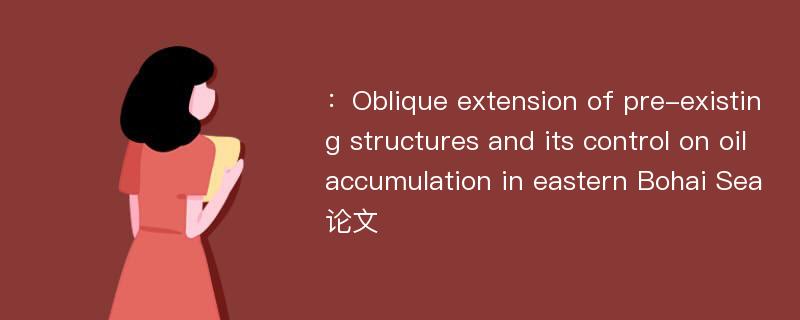
本文主要研究内容
作者(2019)在《Oblique extension of pre-existing structures and its control on oil accumulation in eastern Bohai Sea》一文中研究指出:Based on 3 D seismic data, the evolution mechanism and characteristics of faults were investigated to reveal the structural origin and its control on differential hydrocarbon accumulation through comprehensive analyses, including structure style analysis, fault activity analysis, analogue modelling and comparison among the wells. The complex fault system with differently trending faults resulted from strike-slip and rifting in Paleogene was partly activated, developed successively and stretched obliquely by the near-NS extensional stress field in Neogene. In the area little affected by pre-existing faults, new faults nearly perpendicular to the extension direction developed. The structural development in the study area was not caused by transpressional strike slip. Under the oblique extension effect of pre-existing faults, if the angle between the strike of pre-existing fault and the extensional direction is different, the strike-slip and extensional stresses are different in ratio. The larger the angle between the two is, the stronger the extensional component, the poorer the sealing ability of the fault, and the stronger the oil and gas migration capacity will be. Conversely, the smaller the angle between the two is, the stronger the strike-slip component, the better the sealing ability of the fault, and the poorer the oil and gas migration capacity will be. The accumulation condition analysis results considering the fault trend are in good agreement with the oil and gas shows in wells drilled in this area.
Abstract
Based on 3 D seismic data, the evolution mechanism and characteristics of faults were investigated to reveal the structural origin and its control on differential hydrocarbon accumulation through comprehensive analyses, including structure style analysis, fault activity analysis, analogue modelling and comparison among the wells. The complex fault system with differently trending faults resulted from strike-slip and rifting in Paleogene was partly activated, developed successively and stretched obliquely by the near-NS extensional stress field in Neogene. In the area little affected by pre-existing faults, new faults nearly perpendicular to the extension direction developed. The structural development in the study area was not caused by transpressional strike slip. Under the oblique extension effect of pre-existing faults, if the angle between the strike of pre-existing fault and the extensional direction is different, the strike-slip and extensional stresses are different in ratio. The larger the angle between the two is, the stronger the extensional component, the poorer the sealing ability of the fault, and the stronger the oil and gas migration capacity will be. Conversely, the smaller the angle between the two is, the stronger the strike-slip component, the better the sealing ability of the fault, and the poorer the oil and gas migration capacity will be. The accumulation condition analysis results considering the fault trend are in good agreement with the oil and gas shows in wells drilled in this area.
论文参考文献
论文详细介绍
论文作者分别是来自Petroleum Exploration and Development的,发表于刊物Petroleum Exploration and Development2019年03期论文,是一篇关于,Petroleum Exploration and Development2019年03期论文的文章。本文可供学术参考使用,各位学者可以免费参考阅读下载,文章观点不代表本站观点,资料来自Petroleum Exploration and Development2019年03期论文网站,若本站收录的文献无意侵犯了您的著作版权,请联系我们删除。
